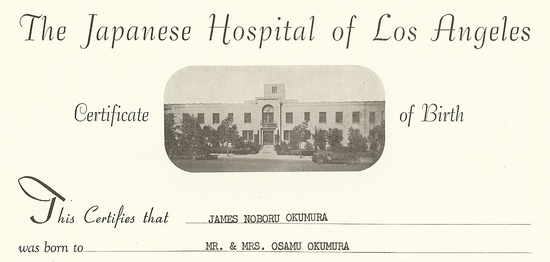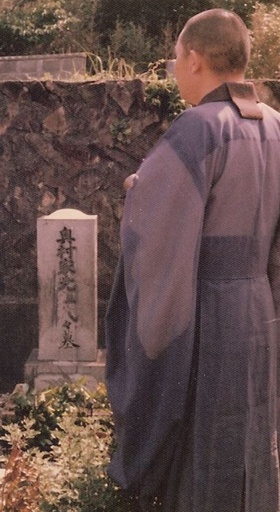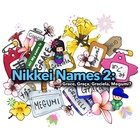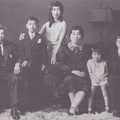My parents named me James Noboru Okumura. My birth certificate from The Japanese Hospital of Los Angeles declared my full name in uppercase 1950s typewriter font. I have known that name since the time I could recognize it.
My parents chose my given name, James, because they wanted to give me an acceptably American name. It sounded nice, but I have no ancestors with that name. As a young child, I never answered to James. My family and our lifelong family friends, the Badrenas and the Ishidas, called me Jimmy or by my nickname, Pee Wee, because of my small stature. Ironically, at birth I weighed in as a heavyweight 8 pounds, 9½ ounces healthy baby. Nicknaming me Pee Wee was like calling someone Chibi or Tiny who is clearly sized triple extra-large. However, by the time I entered public school, I was the smallest kid in the class and stayed that way through the fourth grade. My kindergarten classmates called me Jimmy, and I learned to spell it with a ‘Y.’
We studied Spanish in elementary school. I learned Diego is Spanish for James. I liked that name. It reminded me of family vacations to San Diego. I was appalled to later learn that Jaime is also Spanish for James. Jaime sounded too much like Hymie, which I knew was a derogatory term, but I was too young and ignorant then to fully understand its anti-Semitic context.
My African American friend, Rick, and his family always called me Jamie. My German American friend, Glen, and his family also called me Jamie, except for Glen’s older brother Paul, who always called me Jamie-san. Interestingly, other African Americans with no connection to either Rick or Glen also affectionately called me Jamie over the years.
As I grew older, Jimmy sounded too superficial, too much like a kid. So, I became James, except to the Badrenas and Ishidas, who had always called me either Jimmy or Pee Wee, or to my friends and their families who had always called me Jamie. Sometime in elementary school, I became James to my family and to the rest of the world.
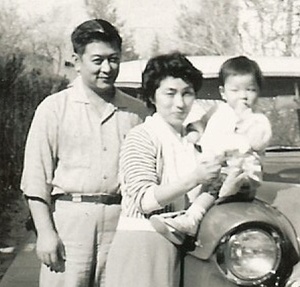
A shortened version of Okumura became the nickname “Okie” for my father and my older brother, but I never inherited that nickname. By the time I entered high school in the early 1970s, our collective memory of the 1930s dustbowl era refugees escaping the drought-stricken prairie to California had been blown away with the wind.
I began to understand how my Okumura surname connected me to my ancestors when I first visited Japan when I was nine. In the late 1960s, our family spent a summer visiting relatives in Tokyo and in our ancestral hometowns in Mie-ken and Kanagawa-ken. The discovery of meeting cousins, aunts, uncles, and my last living grandparent ignited my interest in family history. Paying ohakamairi respects to our ancestors at the family ohaka gravesites made me realize I came from a long line of people I had not known about. That trip allowed me to unearth the generational basis for my Okumura surname and set forth the foundation for the Japanese piece of my identity. I began to understand where I came from.
At some point in their lives, if they have one, many people find their middle names annoying or discomforting. I felt that way about my middle name, Noboru. Fellow Nisei Japanese Americans of my parent’s generation commonly gave their Sansei children Japanese middle names. I too fell into that mold. The few times I needed to disclose my middle name was to share it with peers equally uncomfortable with their own middle names, or with government officials, or with bureaucratic administrators.
I learned early on that Noboru means “to rise” or “to climb” in Japanese. It reflected my parents’ hope and wish for their third born child. Gradually, my discomfort with Noboru transformed into curiosity as I grew older and searched for my own identity. During the mid-1970s, my exposure to the Black Power Movement and watching Alex Haley’s TV series Roots inspired me to seek my own ancestral background. Fortunately for me, as I became a young adult, colleges began offering ethnic and gender studies programs and I started a lifelong mission to understand the Asian American aspect of my identity.
That search led me to study the Japanese language and eventually to become a college exchange student in Japan. Very early in that process, I searched for and learned my name in Nihongo. I learned that the kanji characters for my surname, Okumura (奥村), are why it is spelled with the “OKU” romanization.But the kanji character for my middle name, Noboru, remained a mystery. I searched and identified several kanji characters for Noboru with two strong possibilities. One kanji meant “to rise” (昇), the other “to climb” (登). I asked my parents if they knew which one it might be.
But despite their strong Japanese proficiency, they weren’t exactly sure. However, they knew it wasn’t the more commonly used kanji for “to rise” (昇), and that my paternal grandfather had chosen the kanji for Noboru after lengthy consideration. He had practiced shuji Japanese brush calligraphy and had selected the character for my name. When I showed my parents the multiple kanji characters I had identified, they strongly felt my grandfather had chosen the less commonly used kanji “to climb” (登) for my name. They said it looked familiar to them.
In the late 1970s, during a visit to see my Aunt Toyo in Tokyo, we saw her long-time fortune teller friend who ran a small café-snack near Den En Chofu. We stopped by during their afternoon off-hours break. My aunt and I inquired about several subjects over tea, including which kanji might be the one for my middle name.
Upon hearing that question, our host rose from the table, walked behind the bar, pulled a volume from a wall filled with old astrology, palm reading, and other fortune telling reference book sets. After flipping through the pages and pausing to read a bit, my aunt’s fortune teller friend concluded the Kanji character for my name was the one for “to climb” (登). The reference volume contained information about seimei handan (姓名判断), a fortune telling system based upon the number of strokes in the Kanji characters used in names. That day I felt I had confirmed my middle name and discovered my full name. At twenty years old, I became James登奥村.
It took decades before I truly became comfortable with James Noboru Okumura. Honestly, it took a lifetime, but my name now fits me comfortably, like a pair of good broken-in shoes. A few years ago, I reconnected with surviving members of my old family friends, the Badrenas and the Ishidas. They affectionately and reminiscently addressed me as Jimmy and Pee Wee. That sounded right, just like hearing my friends Rick and Glen call me Jamie again. But only because it specifically came from them and connected us from times long ago. Like my given name, James, those nicknames connect me to the American part of my identity.
Noboru Okumura now sounds right, too. Those middle and family names connect me to the Japanese part of my identity, my origins, and to my family’s hope for my future. It has taken me a lifetime to understand that my full name James登奥村 extends far beyond just me. It spans generational time at a cultural crossroad intersection. And I will forever be grateful to those who named me and marked my space in this world.
© 2024 James Noboru Okumura
Nima-kai Favorites
Each article submitted to this Nikkei Chronicles special series was eligible for selection as the community favorite. Thank you to everyone who voted!


